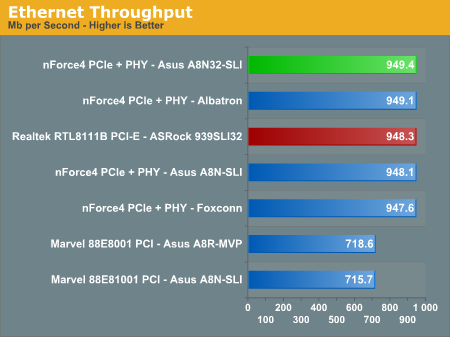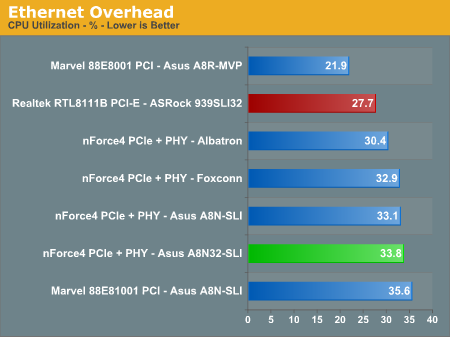ASRock 939SLI32-eSATA2: ULi Dual x16 SLI
by Gary Key on March 2, 2006 12:15 PM EST- Posted in
- Motherboards
Ethernet Performance
The current motherboard test suite includes LAN performance measurements. All of these boards utilize PCI Express controllers with the only difference being the supplier of the core logic.
The Windows 2000 Driver Development Kit (DDK) includes a useful LAN testing utility called NTttcp. We used the NTttcp tool to test Ethernet throughput and the CPU utilization of the various Ethernet Controllers used on the Intel motherboards.
We set up one machine as the server; in this test, an Intel system with an Intel CSA Gigabit LAN connection. Intel CSA has a reputation for providing fast throughput and this seemed to be a reasonable choice to serve our Gigabit LAN clients.
At the server side, we used the following Command Line as suggested by the VIA whitepaper on LAN testing:
All standard Ethernet tests were performed with standard frames and the NVIDIA Active Armor suite disabled unless otherwise noted. Gigabit Ethernet supports Jumbo frames as well and provides a further reduction in CPU overhead.
The current motherboard test suite includes LAN performance measurements. All of these boards utilize PCI Express controllers with the only difference being the supplier of the core logic.
The Windows 2000 Driver Development Kit (DDK) includes a useful LAN testing utility called NTttcp. We used the NTttcp tool to test Ethernet throughput and the CPU utilization of the various Ethernet Controllers used on the Intel motherboards.
We set up one machine as the server; in this test, an Intel system with an Intel CSA Gigabit LAN connection. Intel CSA has a reputation for providing fast throughput and this seemed to be a reasonable choice to serve our Gigabit LAN clients.
At the server side, we used the following Command Line as suggested by the VIA whitepaper on LAN testing:
Ntttcpr -m 4,0,‹server IP› -a 4 -l 256000 -n 30000On the client side (the motherboard under test), we used the following Command Line:
Ntttcps -m 4,0,‹client IP› -a 4 -l 256000 -n 30000At the conclusion of the test, we captured the throughput and CPU utilization figures from the client screen.


All standard Ethernet tests were performed with standard frames and the NVIDIA Active Armor suite disabled unless otherwise noted. Gigabit Ethernet supports Jumbo frames as well and provides a further reduction in CPU overhead.










46 Comments
View All Comments
Gary Key - Saturday, March 4, 2006 - link
It works very well on this board with an Opteron. ;-)Kiste - Thursday, March 2, 2006 - link
In the past, Realtek has solved performance issues by reducing the number of buffers and disabling EAX effects without telling anyone. I hope someone will have a really good look at these integrated audio solutions one day, one that isn't just FPS and CPU utilization.
Gary Key - Thursday, March 2, 2006 - link
To date with the HD Codecs, Realtek has not decreased the buffers nor have we noticed changes in EAX2 output except for the positive. It is a very subjective area to comment on but in BF2 I like the sound quality of the 1.29 drivers better but Serious Sam II seems to have improved a great deal in the 1.30 and 1.31 drivers. While the on-board audio solutions are still lacking in most areas compared to the add-in solutions at least the manufacturers (board/chipset) are trying to improve quality in this area instead of pumping out the same old AC97 codecs. If it were not for the cost I think we would have seen several additional Audigy-SE solutions on the motherboards by now and even possibly an improved offering from Creative. While the A-SE is an older chipset it does offer better performance and audio quality in gaming than the current HD codecs from Realtek, C-Media, ADI, and SigmaTel. I really thought the VIA Envy24 series would have had greater market penetration on the motherboards but one can only speculate as to why this never happened. ;->
tjpark1111 - Thursday, March 2, 2006 - link
is it just me, or does this thing have a 20-pin power connector. ?!?!?!??!???kelim - Thursday, March 2, 2006 - link
Yes, the board does in fact use a 20-pin power connection. If you have a 24-pin PSU, this shouldn't be a problem, since most are 20+4-pin, meaning you can detach the extra 4 pins and only use the ones you need. Either that, or the uneeded pins will hang off the side.Gary Key - Thursday, March 2, 2006 - link
You are correct, it is a 20-pin ATC connector as stated in the article. I was surprised also and did a double take after removing it from the box. :)dab - Thursday, March 2, 2006 - link
It says that this motherboard supports ddr2,"(4) x DIMM, max. 4GB, DDR2 400/333/266, non-ECC, un-buffered memory..."
Is this a joke? There's no 240pin slots on that board, only on the riser (which is not included). s939's IMC doesn't support this either..
Am I mistaken?
Gary Key - Thursday, March 2, 2006 - link
I was just changing that to DDR, sorry about the mistake. The AM2 daughter card will have slots for DDR2 memory.
Puddleglum - Thursday, March 2, 2006 - link
The figure is noteworthy, but it's actually the only Firewire 800 test result I can find in AT's reviews.Gary Key - Thursday, March 2, 2006 - link
I know we only have it in a recent review and probably should drop it. I keep hoping Firewire 800 will be implemented on the higher end boards or those designed for HTPC life. :) However, it appears to be a dead-end option at this point and the technology itself seems to be going away without a fight.